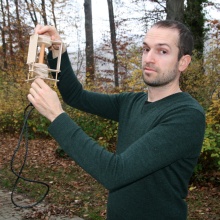The sky's the limit for the research being carried out by the mechanical engineer Dr. Louis Gagnon. Gagnon wants to build an electric aircraft which takes off vertically like a helicopter but which is more agile and compact – and which uses as little energy as possible. This should make an alternative, so-called cyclorotor possible. This is where the name of the aircraft comes from – the cyclocopter.
Energy efficiency comes first and foremost
Energy efficiency has been a constant theme throughout Gagnon’s career as a researcher. Even when he was a mechanical engineering student in Montreal and Quebec City he used to take part in car racing competitions, and together with his team he was given an award for using the least fuel during the race. During his master’s and doctoral thesis at the Laval University in Quebec he turned his attention to cars and trucks. Among other things, he researched which factors influence energy consumption. Here he made contacts with the Polytechnic University of Milan, where he went on to develop his understanding of the multi-body systems of trucks as a guest doctoral researcher. “A lot of people love the freedom that comes with mobility the same as I do, but it hurts me to see the impact this is having on the climate”, says Gagnon.
The Helicopters and Aeroacoustics working group led by Dr. Manual Keßler was recommended to him by his former boss at the Polytechnic University of Milan. “I’ve never built an aircraft before, and I get a lot of help from my colleagues here who have more experience”, explains Gagnon. He says that they eat lunch together and regularly talk about research issues. “It is remarkable how quickly Louis Gagnon has managed to make himself understood in German even in complicated technical conversations”, says an impressed Keßler.
Gagnon first moved to Mannheim a year ago, where he spent four months doing an intensive German course funded by the Humboldt Foundation together with his Italian wife. “It was a challenge at first with having a five-month-old son”, explains Gagnon in his French-accented German. When it came to looking after their son the couple took turns with the child’s grandparents, who had come over from Italy and Canada respectively. The family now live in Möhringen, from where Gagnon usually commutes into the Vaihingen campus by bike.
The rotor is similar to a paddle wheel on a paddle steamer
What Gagnon is lacking in terms of practical knowledge on how to build an aircraft, he makes up for with the six years of research into cyclorotors which he carried out in Italy. The 36-year-old likes to refer to a pocket-sized wooden model to explain how a cyclorotor works. He recently produced the model in the workshop at the institute. The rotor is similar to a paddle wheel on a paddle steamer, except the paddles are replaced by blades. The blades rotate around a horizontal axis along their length, and so produce lift and thrust.
In addition, the angle of inclination of the rotor blades can be changed, meaning that the thrust can be produced in different directions. “This is a big advantage over traditional helicopter rotors which mostly produce thrust downwards”, says Gagnon. When used as cranes, cyclocopters can therefore seamlessly shift between being stationary and moving forwards, and can maneuver their load through cramped construction sites much more precisely. Ultimately, the concept makes it possible to manufacture compact and quiet aircraft. This also means that in future they could potentially be used as flying taxis, which can fly between city streets with tall skyscrapers on either side.
A concept more than 100 years old brought back to life
“The conventional helicopter is well-thought out and works well, but the cyclocopter concept is an extremely interesting idea for use in particular situations”, says Manuel Keßler. However, he still thinks that the cyclocopter needs a significant amount of research to be done first. The first cyclocopters were actually built as far back as the early 20th century, but then the helicopter was invented and the concept was not pursued any further. On the other hand, cyclorotors have proven invaluable to this day on harbor tugboats or ferries, which need to be extremely maneuverable. A few companies and research groups now exist around the world which are looking to develop more lightweight cyclorotors for flying objects.
Gagnon has developed different simulation models for cyclorotors at the aerospace engineering department at the Polytechnic University of Milan in order to be able to test and optimize different rotor designs in advance using computers. For example, the machine engineer uses multi-body simulations to investigate how the different components of a rotor interact with one another. Methods which use numerical fluid mechanics on the other hand make it possible to gain a more detailed look at the airflows and vortexes along the blades.
Flying is great – but better when it uses less energy
Among other things, he has used this method to analyze the aerodynamic rotor properties of an unmanned prototype belonging to a partner company in Austria. “The aim was for the cyclocopter to fly”, says Gagnon. “Now I want to build a cyclocopter which needs less power for the same weight than a conventional helicopter”, he underlines. To do this, he needs more exact simulation models, which he wants to develop during the 2 or 3 years of his scholarship. Gagnon eventually wants to test the most efficient rotor configuration identified on computer in a prototype, which he intends to build himself.




